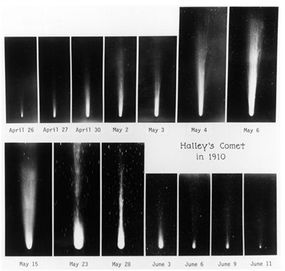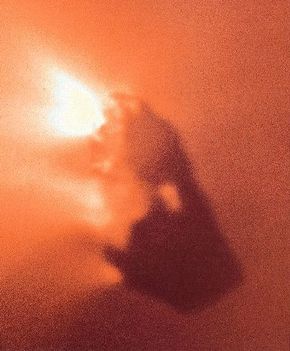Parts of a Comet
As a comet approaches the sun, it warms up. During this warming, you can observe several distinct parts:
- nucleus
- coma
- hydrogen envelope
- dust tail
- ion tail
The nucleus is the main, solid part of the comet. The nucleus is usually 1 to 10 kilometers in diameter, but can be as big as 100 kilometers. It can be composed of rock.
Advertisement
The coma is a halo of evaporated gas (water vapor, ammonia, carbon dioxide) and dust that surrounds the nucleus. The coma is made as the comet warms up and is often 1,000 times larger than the nucleus. It can even become as big as Jupiter or Saturn (100,000 kilometers). The coma and nucleus together form the head of the comet.
Surrounding the coma is an invisible layer of hydrogen called the hydrogen envelope; the hydrogen may come from water molecules. It usually has an irregular shape because it is distorted by the solar wind. The hydrogen envelope gets bigger as the comet approaches the sun.
The comet's dust tail always faces away from the sun. The tail is made of small (one micron) dust particles that have evaporated from the nucleus and are pushed away from the comet by the pressure of sunlight. The dust tail is the easiest part of the comet to see because it reflects sunlight and because it is long, several million kilometers (several degrees of the sky). The dust tail is often curved because the comet is moving in its orbit at the same speed that the dust is moving away, much as water curves away from the nozzle of a moving hose.

Comets often have a second tail called an ion tail (also called the plasma or gas tail). The ion tail is made of electrically charged gas molecules (carbon dioxide, nitrogen, water) that are pushed away from the nucleus by the solar wind. Sometimes, the gas tail disappears and later reappears when the comet crosses a boundary where direction of the sun's magnetic field is reversed.
